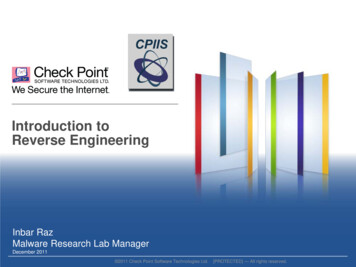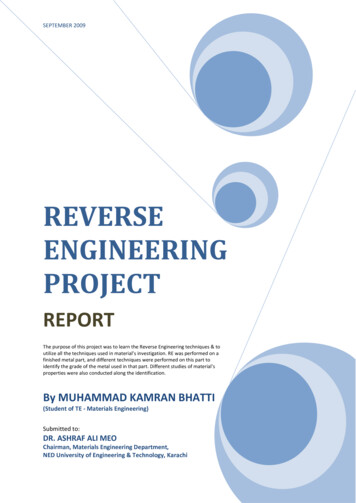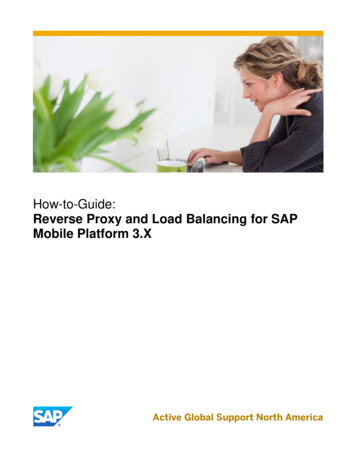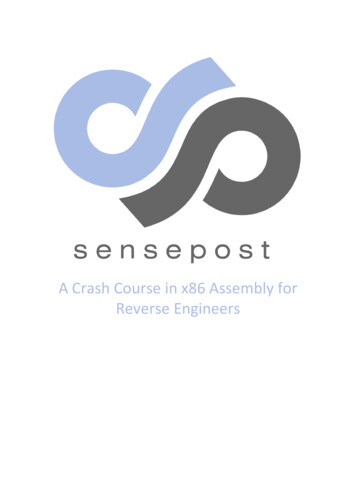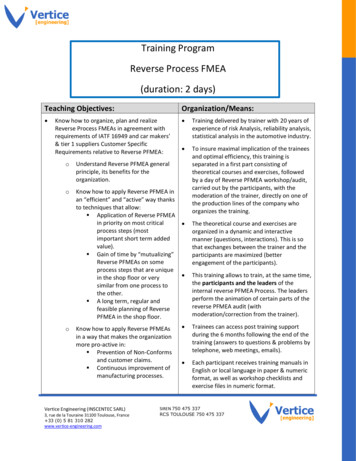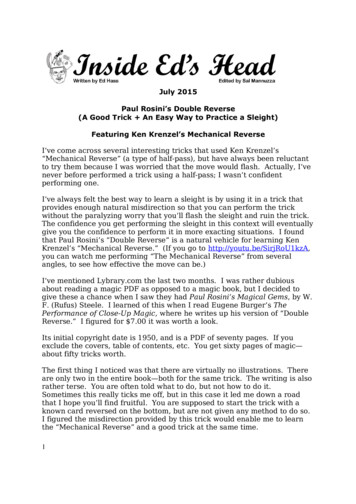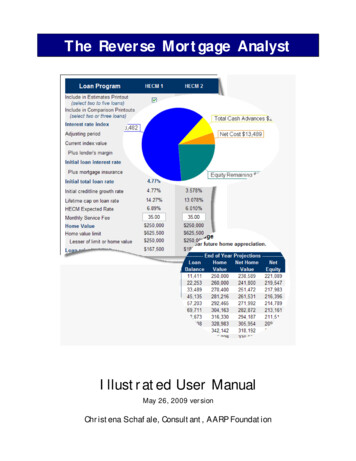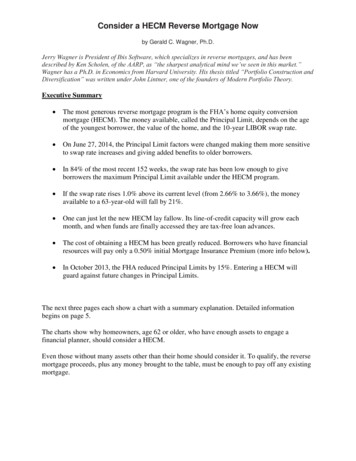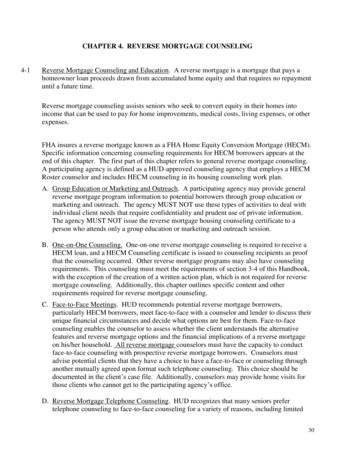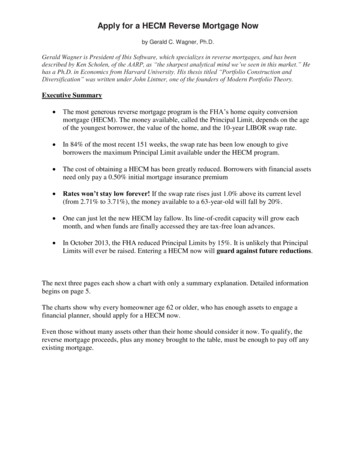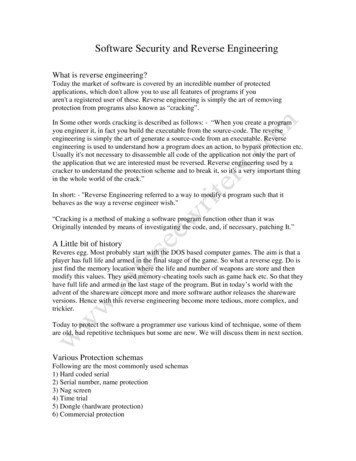
Transcription
Software Security and Reverse EngineeringWhat is reverse engineering?Today the market of software is covered by an incredible number of protectedapplications, which don't allow you to use all features of programs if youaren't a registered user of these. Reverse engineering is simply the art of removingprotection from programs also known as “cracking”.In Some other words cracking is described as follows: - “When you create a programyou engineer it, in fact you build the executable from the source-code. The reverseengineering is simply the art of generate a source-code from an executable. Reverseengineering is used to understand how a program does an action, to bypass protection etc.Usually it's not necessary to disassemble all code of the application not only the part ofthe application that we are interested must be reversed. Reverse engineering used by acracker to understand the protection scheme and to break it, so it's a very important thingin the whole world of the crack.”In short: - "Reverse Engineering referred to a way to modify a program such that itbehaves as the way a reverse engineer wish."“Cracking is a method of making a software program function other than it wasOriginally intended by means of investigating the code, and, if necessary, patching It.”A Little bit of historyReveres egg. Most probably start with the DOS based computer games. The aim is that aplayer has full life and armed in the final stage of the game. So what a reverse egg. Do isjust find the memory location where the life and number of weapons are store and thenmodify this values. They used memory-cheating tools such as game hack etc. So that theyhave full life and armed in the last stage of the program. But in today’s world with theadvent of the shareware concept more and more software author releases the sharewareversions. Hence with this reverse engineering become more tedious, more complex, andtrickier.Today to protect the software a programmer use various kind of technique, some of themare old, bad repetitive techniques but some are new. We will discuss them in next section.Various Protection schemasFollowing are the most commonly used schemas1) Hard coded serial2) Serial number, name protection3) Nag screen4) Time trial5) Dongle (hardware protection)6) Commercial protection
7) Other (cd rom check, keyfiles, disabled function etc.)Let’s study this in detail1) Hard coded serial: -This is the simple protection as compared to other. In this kind ofprotection we have to enter only a serial number and this serial number is same for allusers. Serial numbers entered are compared to the original serial through an algorithmand if a user entered correct serial then the software registered.2) Serial number - name protection:-In this kind of protection we have to enter a nameand a serial number. Then our serial no is compared with the original serial, no which isderived from our name using some algorithm. This protection is some time easy andsome times hard, based on the algorithm a programmer use. Example of this typeprotection is most widely used software "WinZip."3) Nag screen :-In this kind of protection a screen come each time a user start theapplication, to remained such that how many days are left or your software areunregistered or any other message. This is a littlie hard to remove. And most of thenewcomers found it difficult as a new programmer to understand pointers (i.e. –WinZip).But if a reverse has enough knowledge of windows API then he can easily remove thenag screen.4) Time Trial: - According to ORC This kind of protection has any of followingprotection or combination of following protection schema: a) To a predetermined amount of days, say 30 days, starting with the first day ofinstallation. This is referred as "CINDERELLA protection".b) To a predetermined period of time (ending at a specific fixed date)independently from the start date. 'BEST BEFORE a given date' protection.c) To a predetermined amount of minutes and/or seconds each time you firethem. 'COUNTDOWN' TIME PROTECTIONS' example of this kind ofprograms are some games and audio video player which allows an unregistereduser to play game for some amount of time say 5 minutes etc.d) To a predetermined amount of 'times' you use them, say 30 times. Strictlyspeaking these protections are not 'time' dependent. But they depend only on thing"HOW MANY TIMES YOU EXICUTE THEM"5) Dongle Protection: - this kind of protection is supposed to be toughest protection tocrack. This protection is consisting of an EPROM, which was connected with a port oncomputer. The program which is protected by this is first cheeks the presence of this andthen cheeks that the program is registered or not all though it implementation is too hardand hence this kind of protection is not very widely used. This is used in Big Protectedshareware’s. This protection is used by a I/O LPT port (hardware) You will need theregistration Card attached To your PC's parallel port Or other in order to make Theprogram fully work, otherwise it will be Expired after xxDays / xxUses /rippled or itwon’t work at all. Dongles such as: HASP / Sentinel are most commonly used. Donglesuses DLLs/VxD to check the "is registered"
Dongle API is also used for some checks.Example of programs, which uses this kind of protection, included some version of CADetc.6) Commercial protection: - Most of the software programmer don’t want to spendthere precious time in deciding which kind of protection they used to protect theresoftware. Because they think that instead of the spending there time on designing thesecurity algorithm of there programs, why not they spend time to improving thefunctionality of there program? And here comes the concept of commercial protection.Today some software company’s designs only security algorithm for various software.Also they provide general software, which converts fully functional software in tounregistered version and after paying the registration.This software gets converted back in to the fully functional registered software afterentering the registration details. some of the companies which uses commercialprotection for there software are macromedia, Symantec etc and some companies whichprovides this type of protection are preview systems (vbox protection) etc.Although this kind of protection has high security because they are professionallydesigned but they also have some disadvantages. One major disadvantage is that "if aperson cracks only one program which is protected using this protection, then he hascracked the entire program which uses this kind of protection!!!!".For example if a cracker has cracked the flash mx (which is protected by vbox) then hewas able to crack easily all the macromedia software such as dream waver mx etc.,because all these programs are based on only one kind of protection!And in the real world there is no protection, which is still uncracked.7) Other protections: - There are many other techniques which are used to protectsoftware. These are generally used in computer games. Such as cd rom protection,disabled function etc. I think most of computer user are familiar with this protection andalready seen this kind of protection. For example: - If a user doesn’t have cd for aparticular game then he cannot be able to play the game directly from hard disk. Becausewhen one runs the program then the program checks for the cdrom.Also some protection schemes have disabled functions such as you cannot save yourwork or you cannot use any particular function etc.So I hope now you understand all the protection schemas, which used to protect software.Ok let’s study how reverse engineering is done. The first thing to keep in mind thatcracker always works with the disassembly and they are familiar with the windows API.
Now all of us computer user knows that computer only understands binary nothing else.So first we create a program and then compile it now what compiler does is check forsyntax, any error and then he generate the .obj file. As in high level language somefunction are prewritten which are stored in library file hence after this we used linkerwhich links the programs with the library file and then after linking we get an exe filehence exe file we use is nothing but the collection of instruction in binary formats.Now to reverse engineer there are different tools available.TOOLS OF THE TRADEThe popularity of Windows and the ease of creating programs for this platform have leadto the development of thousands of shareware programs. Crackers usually work with theassembly code, reverse engineering it, and have an excellent grasp of the Windows APIsas well.There is no one particular method to crack a program. Depending upon the program andthe kind of protection it has, crackers employ different techniques to get into the program.But there are some common tools that crackers employ to start cracking the program.These programs are perfectly legal and useful by themselves.They are: 1) Debugger2) Dissembler3) Hex-editor4) Unpacker5) File Analyzers6) Registry monitor7) File monitorThis is the tools, which a cracker used to reverse engineer any software. Let we have takea detail look on them.1) Debugger: -all of us know that debugger is a utility to debug the program. Aprogrammer use debugger to find bugs in their program. Debugger is only tool by whichwe can trace/break a function or code live. There are many debuggers available in themarket. We all know how to debug any program, first we put a breakpoint on the requiredstatement and then we run the program. When this instruction is near to be executed theprogram stops and we can see values! This thing is directly related with cracking.Generally software programmer uses windows API function to get the serial number or tocreate nag screen or dialog boxes. Now if a debugger support breakpoint on execution ofape then a cracker easily set a breakpoint on API such as "getwindowtexta" and then aftertracing only some lines of code he can easily find the algorithm to used the generate keyand the key itself!!!
There are many debuggers available in the market but one of the most popular and apowerful debugger is SOFTICE from NUMEGA CORPORATION. This debugger is sopowerful that earlier version of this debugger used to crack himself!!!! Almost all thecracker in this world is using this debugger. So after seeing its misuse NumegaCorporation has kept some restriction on the sale of this great debugger and a buyer mustshow that he will not use this debugger for illegal activities. But cracked copy of thisdebugger is freely available on the net. This is a system level debugger, which worksdirectly between a computer's hardware and windows. We cannot load this debuggerwithin windows. We must load this debugger before windows loads in to the memory. Itcan monitor every process, threads silently in memory until we call it up using hotkeys.It allow us to patch memory at runtime (not permanently and hence we have to use hexeditor.) viewing the contents of the register, contains at memory address etc.2) Disassembler: - As an executable file is in binary format so a normal user cannotunderstand the instruction in this file. Also any exe or executable is generally in PEformat (which is a standard format for exe file, decided by the committee of softwarecompanies like MICROSOFT, IBM, and AT&T. For more about exe search any virusrelated site or /simply search your favorite search engines.) Hence a cracker firstdisassemble the program .now a Disassembler converts the binary file in its equitantassembly language instruction’s most of program is written in high level language hencesize of the disassembly goes in millions (or even larger) of lines and hence it is notpossible for any cracker to understand this code. And hence cracker generally looking forstrings in this disassembly such as; -"your 30 day trial period has expired." Or "theserial no you entered is not valid!!!" Etc.Then they trace the assembly code some lines and simply reverse the jumps. (Forexample one to jump) so that control did not come on this string and go to the statementsuch as "thanks for registration!!!"(We will see later how this can be done but currentlythis info is enough for you.)Now there are many dissembler available. But two of them, which are most commonlyused, are WIN32DASM and IDA .IDA is a powerful debugger then WIN32DASM andused for advanced cracking. But WIN32DASM is most widely used debugger bynewcomer and intermediate crackers. This debugger allows you to disassemble any filewhich is in PE format, we can save disassembly .it can tell us which function is imported,which function is exported, we can execute jump, call, find string data reference anddialog reference easily and many more facilities it provides like we can executes the exefile, step in to it, step over and blah, blah.
3) Hex Editor: -as I mention above that softice can change the value at memory locationonly at the run time. Now this is not useful or not a good cracking if we have to changethe value each time we run the program. Therefore we use hex editors. A hex editorallows us to change the contents of any file in hex format. It displays the contents of thefile in hex format. We can simply have to change the value at memory location which wefind using softice. Now there are a lot of hex editor available such as ultredit, biew, hiewand a lot (I think many c, c programmers has developed it).But the most popular among these is HIEW. Which stands for “Hacker's vIEW". Thislittle program offers a lot of facilities such as editing in hex or ASCII format, searchingany string in hex or ASCII format. There is another good facility which makes it differentfrom others is that, it offers you to write the assembly code and it can automaticallyconvert this code in to equitant hex format. This is helpful for the crackers who don’tknow equitant hex value of assembly instruction. (For example: - if we have to change
protection from programs also known as “cracking”. In Some other words cracking is described as follows: - “When you create a program you engineer it, in fact you build the executable from the source-code. The reverse engineering is simply the art of generate a source-code from an executable. Reverse

